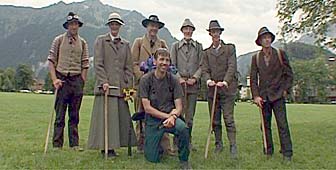19th century mountain expedition returns to present

A team of seven British mountaineers and Swiss guides who have been recreating a 19th century alpine expedition dressed in costumes of the period, ended their 10-day adventure in style at Interlaken's Victoria-Jungfrau hotel.
A horse-drawn carriage was waiting at Interlaken station to take the team to the Hotel Victoria-Jungfrau, where they were greeted by two alphorn players together with a large crowd of camera-clicking tourists, well-wishers and journalists.
A champagne reception laid on by the hotel was a reminder that the team had now left the primitive huts in the mountains far behind.
“We were treated like our 19th-century aristocratic predecessors,” said Philip Martineau as the team toasted the successful conclusion of the expedition.
The team began their journey in Mörel on a sweltering hot afternoon on August 26, heading up toward the Aletsch Glacier on the first long hike of the expedition.
The fine weather continued for the first four days of their alpine adventure, allowing the team to launch successful assaults on the Jungfrau at 4,158 metres above sea level and Mönch at 4,099 metres.
After marching to the top of the Mönch dressed in a pair of tweed breeches borrowed from her father, Alison Henry, the only female member of the Alps Walk team, remarked simply that from her vantage point she could see “the whole world”.
High spirits throughout
Philip Martineau, one of three British climbers on the Alps Walk team, said the heavy snow and rain which disrupted the schedule during the latter half of the expedition was never enough to dampen the group’s spirits.
“The ascents of the Jungfrau and Mönch were great fun,” he said, “but I think I’ve also become more aware of the aspect of the expedition which was emphasising how the Alps have changed over the last 150 years.”
Apart from the chance to take in breathtaking views from Alpine peaks, one of the main purposes of the Alps Walk project was to show how mountaineering has changed since the golden age of the sport at the turn of the century.
The use of 19th century equipment was not just a 21st century gimmick, but an experiment to determine whether mountaineering had become any easier in the intervening decades.
The team quickly discovered, for example, that their authentic, turn-of-the-century long-handled ice-axes doubled as convenient walking sticks when trudging across icy glaciers, but proved cumbersome on the steep slopes of the Jungfrau.
Though the equipment may have changed with the passage of time, the group did discover some places which had barely changed over the past 150 years.
Primitive conditions
On days when they stayed in primitive mountain huts, spending bitterly cold evenings sipping hot tea made from melted ice and sitting around fires lit by wood chopped by the team’s guides, the group realised it had escaped as far away as possible from civilisation in Switzerland.
The scenery and standards of accommodation enjoyed by the group were as varied as the Alpine peaks are numerous.
“It’s been a trip of immense contrast,” Henry said.
“From the cosy simplicity of the Bergli Hut, to the slightly faded splendour of the Hotel Bellevue-Des Alpes at Kleine Scheidegg, from the barren icy landscapes at the head of the Aletsch Glacier, to the tranquil pastoral scenes below the Faulhorn, and from sweltering sunshine to violent thunderstorms.”
Despite the inherent danger of climbing the mountains in good or bad weather, the Alps Walk team managed to complete the expedition virtually unscathed.
Les Swindin, who since the start of his mountaineering career in 1965 has climbed all of the 4,000 metre peaks the Alps has to offer, was the only member of the team to sustain an injury, when he fell flat on his face after slipping on an icy doormat outside a 19th century hotel.
Classic comic timing
Swindin is the first to admit his fall was a classic example of comic timing and says the rest of the team has been ribbing him mercilessly ever since.
But the team camaraderie, said Swindin, was proof that all seven members of the group had quickly bonded through their mutual love of climbing and affection for the mountains.
For Henry, the expedition was more than just a daily series of early starts and tortuous climbs up steep slopes.
“It really has been a journey of personal discovery,” Henry said.
“I’ve been pushed to my physical limits, but encouraged by the rest of the team always found the determination to go on. I’ve found that the greatest pleasures do not necessarily lie in conquering the highest peaks.”
swissinfo

In compliance with the JTI standards
More: SWI swissinfo.ch certified by the Journalism Trust Initiative









You can find an overview of ongoing debates with our journalists here . Please join us!
If you want to start a conversation about a topic raised in this article or want to report factual errors, email us at english@swissinfo.ch.